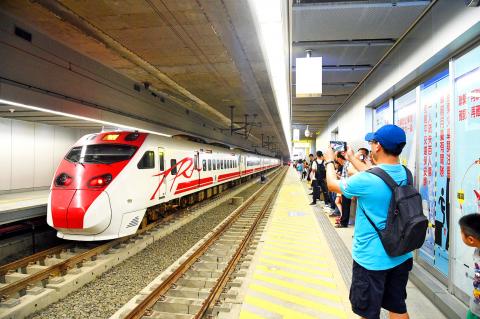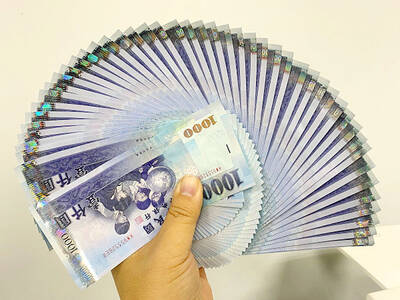An underground railway line officially opened in Kaohsiung yesterday following almost 10 years of construction, the Ministry of Transportation and Communications’ Railway Bureau said.
The line would eliminate all ground-level railway tracks in downtown Kaohsiung, as well as seven railway crossings and 16 flying junctions, it added.
The opening of the line and the new Kaohsiung Railway Station was marked at a ceremony attended by Premier William Lai (賴清德), Presidential Office Secretary-General Chen Chu (陳菊), Minister of Transportation and Communications Wu Hong-mo (吳宏謀) and Railway Bureau Director-General Allen Hu (胡湘麟).

Photo: Chang Chung-yi, Taipei Times
Lai thanked the construction team for their hard work over the years, as well as Kaohsiung residents who put up with the construction for the past decade.
The central government and the Kaohsiung City Government should continue working together to finish the project’s second phase, which includes building a “green corridor” using the land previously occupied by railroad tracks and commercial buildings at the Kaohsiung and Fengshan railway stations, Chen said.
Eliminating railway crossings and junctions would improve the traffic in downtown Kaohsiung and reduce traffic accidents caused by trains, Wu said.

Photo: Chang Chung-yi, Taipei Times
The project also helps to connect areas previously divided by railway tracks, balance the development of different districts in the city, raise land values and improve city residents’ quality of life, he said.
Hu pointed to the difficulties faced while building the underground railway line, which passes under the Love River (愛河).
The most challenging part of construction was the new Kaohsiung Railway Station, which would be used by the Taiwan Railways Administration (TRA) as well as the Kaohsiung MRT system, he said.
The two systems had to continue operating during the construction of the new line, which proved to be challenging, Hu said.
The underground line between Zuoying (左營) and Fongshan (鳳山) is 15.37km long, the bureau said.
It connects 10 railway stations, including Zuoying, Kaohiung, Fongshan and seven new railway stations built for commuters, it added.
The TRA originally planned to launch the new line at 6am, but the first southbound train did not depart from Zuoying until 6:18am and the first northbound train did not leave the terminal station until 6:45am.
One of the railway signals along the northbound line between the Museum of Arts Station and Zuoying malfunctioned at 6:46am, affecting four trains and about 1,890 passengers, the TRA said, adding that the signal was repaired at 7:40am.
In related news, the TRA is on Thursday to release its railway calendar for next year, featuring scenes captured along the railway line between Hualien and Taitung.
The railway agency said that it would only print 1,000 calendars, adding that people can buy them in Taipei Railway Station, as well as Songshan, Nangang, Taichung, Hualien and Kaohsiung stations.

Taiwan is projected to lose a working-age population of about 6.67 million people in two waves of retirement in the coming years, as the nation confronts accelerating demographic decline and a shortage of younger workers to take their place, the Ministry of the Interior said. Taiwan experienced its largest baby boom between 1958 and 1966, when the population grew by 3.78 million, followed by a second surge of 2.89 million between 1976 and 1982, ministry data showed. In 2023, the first of those baby boom generations — those born in the late 1950s and early 1960s — began to enter retirement, triggering

ECONOMIC BOOST: Should the more than 23 million people eligible for the NT$10,000 handouts spend them the same way as in 2023, GDP could rise 0.5 percent, an official said Universal cash handouts of NT$10,000 (US$330) are to be disbursed late next month at the earliest — including to permanent residents and foreign residents married to Taiwanese — pending legislative approval, the Ministry of Finance said yesterday. The Executive Yuan yesterday approved the Special Act for Strengthening Economic, Social and National Security Resilience in Response to International Circumstances (因應國際情勢強化經濟社會及民生國安韌性特別條例). The NT$550 billion special budget includes NT$236 billion for the cash handouts, plus an additional NT$20 billion set aside as reserve funds, expected to be used to support industries. Handouts might begin one month after the bill is promulgated and would be completed within

The National Development Council (NDC) yesterday unveiled details of new regulations that ease restrictions on foreigners working or living in Taiwan, as part of a bid to attract skilled workers from abroad. The regulations, which could go into effect in the first quarter of next year, stem from amendments to the Act for the Recruitment and Employment of Foreign Professionals (外國專業人才延攬及僱用法) passed by lawmakers on Aug. 29. Students categorized as “overseas compatriots” would be allowed to stay and work in Taiwan in the two years after their graduation without obtaining additional permits, doing away with the evaluation process that is currently required,

IMPORTANT BACKER: China seeks to expel US influence from the Indo-Pacific region and supplant Washington as the global leader, MAC Minister Chiu Chui-cheng said China is preparing for war to seize Taiwan, Mainland Affairs Council (MAC) Minister Chiu Chui-cheng (邱垂正) said in Washington on Friday, warning that Taiwan’s fall would trigger a regional “domino effect” endangering US security. In a speech titled “Maintaining the Peaceful and Stable Status Quo Across the Taiwan Strait is in Line with the Shared Interests of Taiwan and the United States,” Chiu said Taiwan’s strategic importance is “closely tied” to US interests. Geopolitically, Taiwan sits in a “core position” in the first island chain — an arc stretching from Japan, through Taiwan and the Philippines, to Borneo, which is shared by